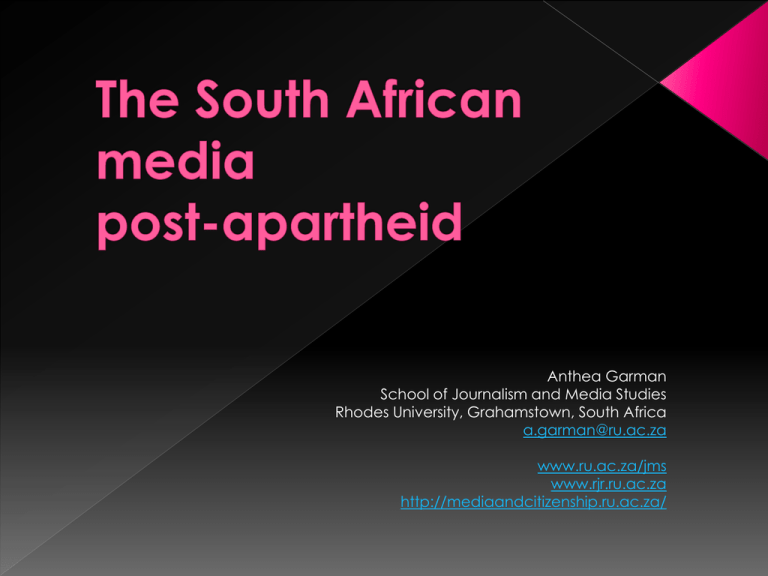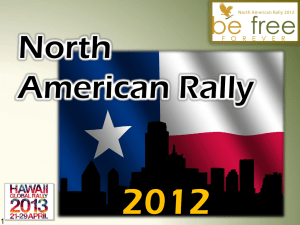The South African media post
advertisement

Anthea Garman School of Journalism and Media Studies Rhodes University, Grahamstown, South Africa a.garman@ru.ac.za www.ru.ac.za/jms www.rjr.ru.ac.za http://mediaandcitizenship.ru.ac.za/ – “The newsroom of South Africa today is a ship sailing into extreme headwinds of change from digital disruption, regulatory change and government hostility to downsized newsrooms, declining circulation and shifting revenue models.” STATE OF THE NEWSROOM SOUTH AFRICA2013 report edited by Glenda Daniels http://www.journalism.co.za/docs/WJ_Report_pages2709LR_update2.pdf 359 newspapers: 15 weeklies; 32 weekenders; 219 free newspapers; 58 locals; 28 dailies and six hybrids, 518 magazines (consumer, entertainment, business, sport and specialist publications). About 1.3-million copies of newspapers are sold (population of 52million). Most publications are in English with some in Afrikaans and isiZulu. Newspapers are urban based, with an urban bias. Steady decline in newspaper circulation: 5.5% since 2008. Magazine sales declined in 2013 by 0.2%. 1 online-only newspaper The Daily Maverick. Most newspapers have adopted the “porous pay wall” method for their online versions (this has usually resulted in an overall loss of readers). The major companies are: Times Media Group Caxton&CTP Independent Newspapers Media24 Mail & Guardian – the sole remaining ‘alternative’ newspaper from the apartheid era. Independent Newspapers sold to the South African consortium Sekunjalo Independent Media. Plans to expand into indigenous languages, expand into other parts of Africa and grow digital presence. The ANC’s criticism: the print media is lacks diversity in ownership and control, race, language, gender, and content. Black ownership (using the Media Development and Diversity Agency’s statistics), is 14% and women’s representation at board and management level is 4%. The Parliamentary Committee on Communication: the print media does not reflect a diversity of South African voices; they marginalise the rural and the poor; they are white-dominated not just in ownership but also in issues covered; and there was “cartel-like” behaviour involving community newspapers. Media 24: 24 white editors out of 30, 704 journalists 267 white females, 213 white males, 133 black males and 91 black females. Independent Newspapers: 60% of editorial staff black, females just fewer than 50%. Of the 19 titles 10 had black editors (3 women). 9 titles white editors (5 female. 50% black managers (1 female). Mail&Guardian: Of a staff of 149, 81 were black and 68 were white. In the leadership 21 black men and 38 black women, 20 white males and 28 white females. The majority of employees were women and the biggest single category was black women. 245 titles primarily located in rural and disadvantaged areas (Association of Independent Publishers). 97 publish in indigenous languages. 219 free newspapers with a distribution of 6 195 065. 58 local newspapers with a circulation of 482 000. Dominated by the SABC radio and television channels (but the SABC TV stations have lost a million prime time viewers in the last year). Radio: 20 public radio stations; 16 commercial stations; 130 community radio stations. The total adult radio listening population is 31 million and of that nearly 9 million listen to community stations. SABC broadcasts in all official 11 languages plus KhoiSan. Ukhozi FM in isiZulu has 4.3-million listeners. Television: according to Census 2011, households in SA have more TVs than radios. 3 commercial operators: e.tv (7pm news gets 3.5-million viewers), DSTV (satellite and paid for with 20% Chinese ownership and 25% of SA households) and TopTV (run by On Digital Media). Africa News Network is a new channel (since August 2013) owned by the Gupta family of India. 7 licensed community TV stations (Cape Town TV, Soweto TV, Bay TV, One KZN, Tshwane TV, Bara TV and North West). Media 24: 10% of the editorial workforce in Media 24’s Afrikaans news division in 2012, English titles lost 53 positions. Times Media Limited: March 2012 to April 2013 shed 18 senior staff members. Independent Newspapers cut 3000 jobs since 1994. SABC has cut about 1200 jobs. 12.3-million people are online in SA More people use the internet for information than read a paper daily 5.33 million South Africans are using Facebook and 2.43 million are on Twitter Of adults every day 22% use the internet 17% read a newspaper 47% listen to a radio for more than an hour 62% spend more than R1 on cellphone usage 71% watch TV for more than an hour Media companies have been developing mobile sites and apps in earnest since 2012. The Mail&Guardian’s mobisite gets 250 000 visitors a month and all the major newspapers report this is an upward trend. Naspers developed the app “PriceCheck” which won the international app of the year at the Blackberry Live conference in Florida in May. Pragmatism and a “a platform-agnostic approach” versus protect the print brand Reporting lines can be confusing, and the converged newsroom at times fails expectations. Twitter creates a ‘focus problem’. Being fully engaged in the social-media sphere takes time and hard work; it presents a new approach to news and requires careful preparation and planning. Many journalists report that they are having fun. In many cases it was the older generation that found it easier to incorporate social media and make the transition to digital first. Many journalists felt that being skilled across different platforms and in multimedia was necessary to surviving. There are about 10 different laws that affect how journalists work. These range from those intended to foster access to information, (the Promotion of Access to Information Act of 2000) to laws that have not changed since the apartheid era, such as that governing National Key Points. The Protection of State Information Bill The Media Appeals Tribunal, the Press Freedom Commission hearings and the revamped Press Council The Media Charter And the ANC-Art battle… Introduced in Parliament in 2008 to repeal apartheid-era information/classification legislation. In 2011 amendments were made by the National Council of Provinces (NCOP), which added limited public defence – the ‘some secrecy bill’. The majority of MPs (189 for; 74 against and one abstention) passed the Bill in the National Assembly on 25 April 2013. In September the president sent the Bill back to Parliament. On 13 November it was passed. The Right to Know (R2K) campaign (launched in 2010 as a coalition of organisations to fight the Bill); the Congress of South African Trade Unions (Cosatu); the SA National Editors Forum (Sanef), the Democratic Alliance, and Print and Digital Media South Africa intend challenging it in the Constitutional Court. They have been successful in getting a limited public-interest defence written into it. The R2K held public hearings all over the country and organised marches. Ensure a full public interest defence. Ensure full whistleblower protection. Don’t criminalise the public as spies. Limit the bill to the security agencies. Include a public domain defence. Reduce draconian sentences. Don’t undermine the Promotion of Access to Information Act (PAIA). Introduce an independent review panel. “Let the apartheid truth be told” (apartheid era info remains classified). MAT – parliamentary body for citizens to appeal to (ANC party proposal). Press Freedom Commission – public hearings put in motion by Print Media SA and SA National Editors’ Forum (chaired by retired Constitutional Court judge Pius Langa). Revamped Press Council with boosted public representation and silent ANC. Promotion of Equality and Prevention of Unfair Discrimination Act: no person may publish, propagate, advocate or communicate words that may demonstrate a clear intention to be hurtful, harmful or to incite harm; or promote or propagate hatred. Film and Publications Act: the board takes a very severe approach to child pornography. Brett Murray and The Spear Ayanda Mabulu Un-mute my Tongue "Any portrayal of President Jacob Zuma in this way is disrespectful," ANC spokesperson Keith Khoza told the Mail & Guardian earlier this week. "It makes a mockery of the president's office, his status as a father and husband and is an absolute abuse of the arts.“ Yuill Damaso The Night Watch “In the picture, you see people in whose hands the running of the country currently lies; the cogs that run the machine. My question is: What’s going on while we sleep at night?” There’s also an allusion that someone should be watching those who are supposed to be watching over us… • Business (economics, finances and profits for media owners and a desperate desire for business-as-usual (ie normality) for journalists) gets in the way of a commitment to transformation – racial, journalistic (in terms of stories that can be told), linguistic and cultural. • Fuelled by the desire to become part of the globalised world and emulate the ‘progress’ of the North, especially digitally. “The Twitter elite is inescapable… this group can set the agenda for discussion, and also influence the direction of discussion. This is an important role… given the lack of a strong political opposition. Their Twitter ratings give them the opportunity to voice criticism and opposition…” Verweij and Van Noort 2013. http://hacks.mediahack.co.za/ The ‘white’ attitude: We pay our taxes therefore we have done our duty as citizens. You spend our money carelessly and corruptly. The new SA is a post-race space – the only racism is that invented by the new elite (and usually aimed at the white minority). Stop blaming your incompetence on the ‘legacy of apartheid’. You are beyond the pale; therefore no dialogue is possible. Our outrage is so righteous that we do not need to stop and check our assumptions. The media attitude: There is no credible opposition, so we have to be the political opposition. We speak for those most affected; they are too poor/rural/sick/young/uneducated to speak for themselves. Some ubuntu – treat everyone with humanity and decency, listen more, be extremely careful of adopting highhanded attitudes fuelled by moral outrage. Stop trying to speak on behalf of and for the majority – put in place mechanisms to listen and to make space for their speech. Let the citizens do their own work! Beware of the ‘view from the suburbs’ (Steven Friedman); the middle class approach – and rush to judgment – to politics, education, community, business, problem-solving, etc. Be in dialogue as a state of mind and politics. Hold on to the precious things learned in the struggle: solidarity, broad-based action. Think texture and translation (Yves Vanderhaeghen) – tell ‘thick’ stories and tell them across the divides. Tell stories that enable understanding, agency, dialogue and solidarity instead of disillusionment and frustration.









